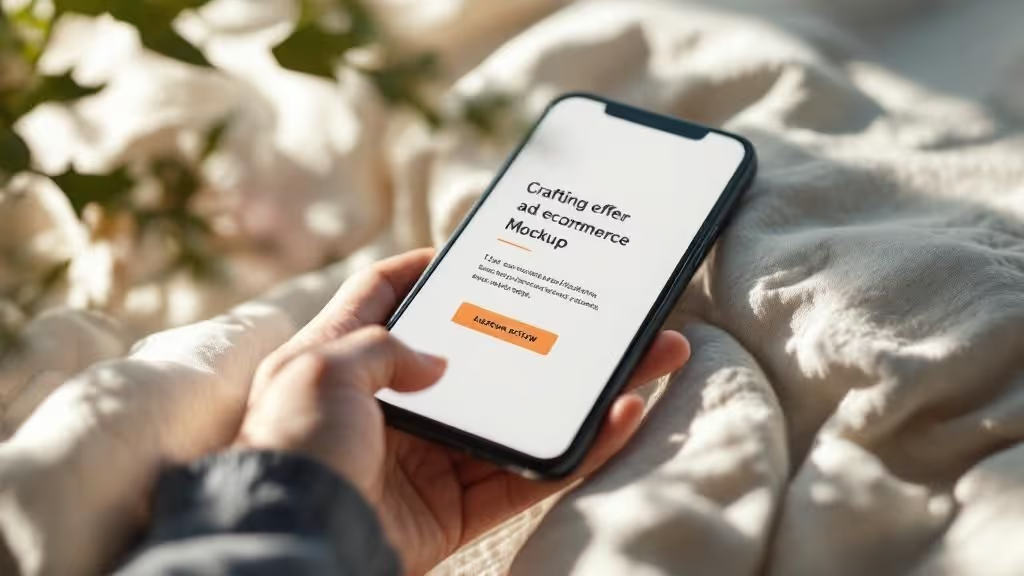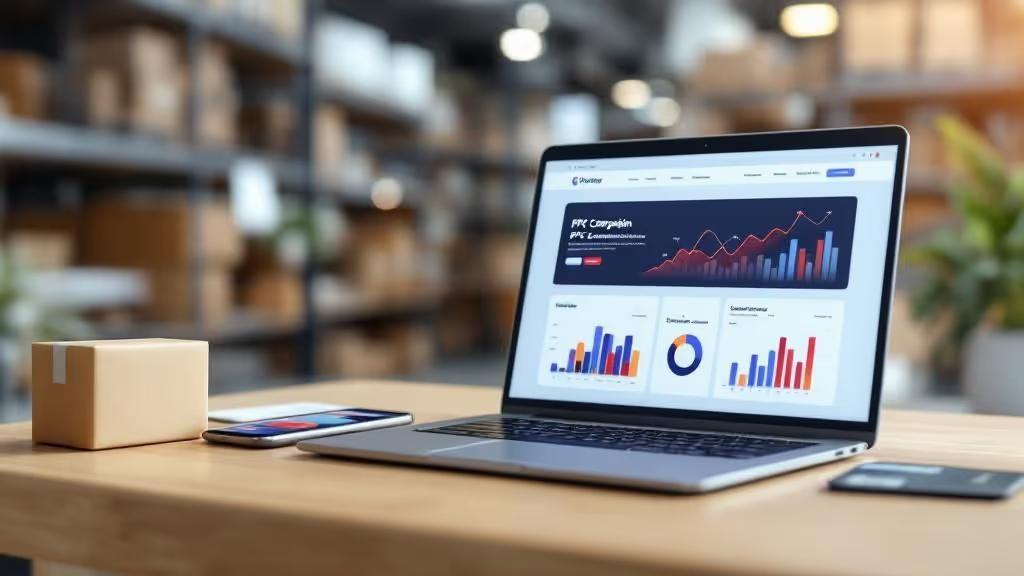In the competitive world of e-commerce, PPC is your most direct line to customers actively looking to buy. Imagine placing your products on the best shelf in the store, right at eye level, just as the perfect customer walks down the aisle. It’s a powerful way to drive traffic and sales now, without waiting for organic strategies to mature.
Why PPC Is Your E Commerce Growth Engine
The "SEO vs. PPC" debate is outdated. A modern digital strategy requires both. While SEO is your long game for building brand trust and organic authority, paid advertising is the rocket fuel for immediate growth. A smart PPC strategy creates a reliable, predictable stream of revenue, allowing you to scale your business and capture market share quickly.
It's about being in the right place at the right time. When a shopper searches for "women's leather ankle boots," a paid ad places your product at the very top of the results page. You capture that critical first click before they even start scrolling.
Driving Immediate and Scalable Sales
The greatest advantage of PPC is speed. Unlike SEO, where results can take months, a well-constructed campaign can start sending qualified buyers to your site within hours. This agility gives e-commerce brands a massive competitive edge.
- Test New Products: Launching a new product line? A small PPC campaign can validate market interest before you commit to a full-scale marketing budget.
- Capitalize on Trends: When a particular style goes viral, you can have ads running in minutes to capture the surge in demand.
- Clear Out Inventory: Need to move last season's stock? A targeted sale campaign can efficiently convert excess inventory back into cash.
This flexibility is key. Better still, PPC is incredibly scalable. Once you identify a campaign delivering a strong Return On Ad Spend (ROAS), you can simply increase the budget and watch the results multiply. It’s a direct lever for growth. To explore the fundamentals further, read our article explaining why PPC is important for your organization.
A Data-Backed Investment
Companies are investing heavily in paid search for a simple reason—it works. The global spend on search advertising is projected to reach a staggering $351.55 billion by 2025. This isn't arbitrary spending; it's driven by proven results.
On average, businesses earn $2 for every $1 spent on Google Ads. And that's just the average. We've seen finely-tuned campaigns achieve returns of 800% or more. Discover more insights about PPC statistics on blog.coupler.io.
For an e-commerce business, PPC is not just an advertising expense—it's a strategic investment in customer acquisition. Every click provides valuable data on what shoppers are searching for, which keywords convert, and what ad copy resonates. These insights can be used to sharpen not just your ad campaigns, but your entire marketing strategy.
Building a Strategic PPC Campaign Structure
A profitable PPC for e-commerce strategy begins not with keywords, but with architecture. Many businesses waste money because their accounts are a chaotic mess. A well-organized campaign structure is your blueprint for success, offering precise control over budgets, targeting, and the data you collect. Without it, you're essentially flying blind.
Think of your account like a physical retail store. You wouldn't dump all your products in a pile on the floor. You’d organize them into logical departments and aisles so customers can easily find what they’re looking for. Your PPC account requires the same thoughtful organization to guide shoppers from search to sale.
The process flows from a high-level strategy down to the granular details of execution, as this graphic illustrates.

This top-down approach is the foundation of any high-performing account.
Segmenting for Profit and Control
The most effective way to structure an e-commerce PPC account is through smart segmentation. This means breaking down your campaigns into logical groups that mirror your business operations and customer shopping behavior.
Here are the most effective segmentation methods:
- By Product Category: This is the most intuitive starting point. An apparel store would have separate campaigns for 'Shoes', 'Shirts', and 'Accessories'. This setup is critical because it allows you to assign different budgets and bids based on the value of each category.
- By Profit Margin: Not all products are created equal. High-margin items can sustain a higher cost per acquisition. By creating campaigns specifically for your most profitable products, you can afford to bid more aggressively to secure those valuable sales.
- By Brand vs. Generic: This is non-negotiable. You must separate campaigns targeting your own brand name from those targeting generic product searches. Shoppers searching for your brand are already sold on you; these clicks are inexpensive and convert at a high rate. Generic campaigns are for acquiring new customers and require entirely different bidding strategies, ad copy, and performance expectations.
This level of organization prevents high-performing products from being dragged down by unprofitable ones and gives you a clear view of what’s truly driving growth.
The Power of Hyper-Specific Ad Groups
Within each campaign, you build your ad groups. This is where you get granular. A common mistake is creating a single ad group for "women's boots" and stuffing it with dozens of mismatched keywords. This is a recipe for low relevance and wasted ad spend.
A superior structure is much more specific. For example, within your "Women's Boots" campaign, you would create ad groups like these:
- Women's Leather Ankle Boots
- Suede Knee-High Boots
- Waterproof Winter Boots
Each ad group should contain only tightly related keywords. For instance, the "Women's Leather Ankle Boots" ad group would include keywords like "black leather ankle boots for women" or "low heel leather booties."
This specificity is the secret sauce. It directly improves your Quality Score—Google's rating of the relevance of your keywords, ads, and landing pages to a user's search. A higher Quality Score leads to lower ad costs and better ad positions, providing a massive competitive advantage.
A Real-World Apparel Store Example
To illustrate this, here’s a blueprint for how an online store, "Urban Threads," might structure its campaigns for maximum clarity and performance.
E-Commerce Campaign Structure Blueprint
Campaign LevelAd Group ExamplesKeyword ExamplesPrimary GoalBrand SearchUrban Threads - Brand"urban threads," "urbanthreads.com"Protect brand, capture high-intent trafficGeneric - DressesSummer Maxi Dresses"long floral summer dress"Attract new customers searching for dressesGeneric - ShoesWomen's Ankle Boots"women's black leather ankle boots"Drive sales for a specific shoe categoryHigh Margin - OuterwearPremium Leather Jackets"real leather moto jacket women"Maximize profit on high-value items
This structure ensures that a person searching for a specific product sees an ad that speaks directly to them and lands on a page showing exactly what they wanted. This perfect alignment—from search to ad to landing page—is what turns clicks into loyal customers and builds a scalable, high-performing PPC engine.
Getting Keyword Research Right for Your E-Commerce Store

Every profitable PPC for e-commerce strategy is built on a foundation of meticulous keyword research. This isn't just about plugging terms into a tool; it's about understanding the customer's mindset to identify the exact phrases they use when they're ready to buy.
Dig for High-Intent Keywords
The most valuable keywords are not broad, single-word terms like "shoes." Competition for these is fierce, the cost-per-click is high, and the searcher's intent is unclear. Instead, focus on long-tail keywords—longer, more specific phrases that reveal exactly what a shopper is looking for.
Consider the difference:
- Broad Keyword: "yoga mat" (Is the user looking for reviews, cleaning tips, or just browsing?)
- Long-Tail Keyword: "eco-friendly cork yoga mat for beginners" (This person knows what they want and is likely ready to purchase.)
While long-tail keywords have lower search volume, their conversion rates are significantly higher. To find them, go beyond standard keyword tools. Analyze your own website's internal search data, read customer reviews to learn their language, and explore forums like Reddit to see how potential customers discuss your products.
Analyze Your Competitors' Strategies
Why start from scratch? Your competitors are already spending their ad budgets to discover what works. You can gain valuable insights by analyzing their paid search strategies. Tools like Semrush or Ahrefs can reveal the exact keywords your rivals are bidding on, providing an excellent starting point for your own research.
However, don't just copy their list. Your goal is to find the gaps. Are they overlooking a product feature your customers value? Are they missing specific long-tail searches you can dominate? This competitive analysis helps you carve out a niche where you can win clicks more cost-effectively.
The real objective isn't just to find keywords; it's to grasp the commercial intent behind them. Any search containing terms like "buy," "deal," "discount," or specific model numbers is a strong signal of purchase intent. These are the keywords to prioritize.
The Power of Negative Keywords
Knowing which searches you don't want to appear for is as crucial as knowing which ones you do. A well-maintained negative keyword list is one of the most effective ways to prevent wasted ad spend. It instructs Google to exclude your ads from irrelevant searches.
For instance, if you sell premium leather wallets, you should add negative keywords like:
- "free"
- "cheap"
- "DIY"
- "how to make"
Without these exclusions, you risk paying for clicks from users with no intention of buying. This erodes your budget and skews your performance data. Regularly review your search term reports to identify new negative keywords and keep your campaigns laser-focused on qualified buyers.
Matching Keywords to the Customer's Journey
Once your keywords are identified, organize them into tightly-themed ad groups that lead to highly relevant landing pages. This alignment creates a smooth, logical path from a user's search to their purchase.
If someone searches for "women's black leather ankle boots," they should see an ad that specifically mentions those boots and directs them to a page featuring that exact product.
This tight match between keyword, ad, and landing page boosts your Quality Score, which lowers your cost-per-click. With 65% of consumers clicking on ads for specific products, getting this right is non-negotiable. Shoppers expect a seamless experience, and a meticulous keyword strategy is the only way to meet that expectation and drive sales.
Crafting Ads and Landing Pages That Convert

Earning a click is only the first step. The real challenge is converting that click into a sale. A successful PPC for e-commerce campaign creates a seamless and persuasive journey from the ad to the final "thank you for your order" page.
Think of it this way: your ad makes a promise, and your landing page must deliver on it. A disconnect between the two wastes your ad spend and loses a potential customer.
Writing Ad Copy That Drives Action
Your ad copy is your digital salesperson. In just a few lines, it must cut through the noise, highlight your product's value, and convince a searcher that you have the solution they need. This means moving beyond a simple list of features to address what your customers truly care about.
Identify what makes you different. Your unique selling propositions (USPs) are what will earn you the click over a competitor.
- Free Returns: This removes the risk for the shopper, making them more confident to click "buy."
- Lifetime Warranty: This instantly communicates quality and durability, building trust by showing you stand behind your product.
- Next-Day Shipping: In an era of instant gratification, fast delivery is a powerful incentive. If you can deliver faster than your rivals, make it a focal point.
Generic ads get lost in the noise. An ad that solves a specific problem or eases a common fear is the one that gets the click.
Supercharge Your Ads with Extensions
If you're not using ad extensions, you're leaving money on the table. They are a free way to add more information to your ads, making them larger and more compelling on the search results page.
For example, sitelink extensions can direct users to specific pages like "Best Sellers" or "Sale." Price extensions display the cost directly in the ad, helping to pre-qualify buyers who are serious and ready to spend.
Effective use of ad extensions does more than just add information—it claims more real estate on the results page. This pushes competitors further down and gives users multiple ways to engage with your brand before they even visit your site.
Designing Landing Pages for Conversion
Once you've earned the click, the landing page has one job: convert the visitor into a customer. The most critical element is maintaining relevance to the ad. If your ad promised "women's leather ankle boots," the landing page must immediately display a compelling selection of them.
A high-converting landing page is built on clarity and trust. Every element should guide the user toward the "Add to Cart" button.
- Crisp Product Imagery: Use high-resolution photos from multiple angles and include video when possible. Shoppers want to see details and visualize the product.
- Trust-Building Reviews: Social proof is essential. Star ratings and customer testimonials are non-negotiable. It's no surprise that 19% of marketers view paid search as their most profitable channel—a page full of positive reviews helps close the deal.
- Frictionless Checkout: Make it easy for people to complete their purchase. Eliminate unnecessary form fields, offer a guest checkout option, and provide multiple payment methods. Every extra step is an opportunity for a shopper to abandon their cart.
By perfectly aligning your ad copy with a user-friendly landing page, you create a powerful and reliable engine for turning clicks into customers.
Getting Your Bids and Budgets to Work for You
Once your ads and landing pages are optimized, it's time to focus on the engine room of your PPC operation: bid and budget management. This is where data drives profitability. It's not a "set it and forget it" task; it's a continuous process of allocating funds to top performers and pulling back from underachievers.
E-commerce brands rely heavily on paid ads. A remarkable 80% of companies worldwide use paid search for growth because that traffic often converts 50% better than organic visitors. With search ads accounting for nearly 39.5% of all digital ad spend in the US, mastering this part of the process is essential. You can discover more insights about PPC statistics on cropink.com to grasp the scale.
Choosing the Right Bidding Strategy
Your bidding strategy on a platform like Google Ads can determine the success or failure of your campaigns. There is no one-size-fits-all solution; the best choice depends on your specific goals, data volume, and desired level of control.
- Enhanced CPC (eCPC): This is an excellent starting point for new campaigns. It allows you to set bids manually while giving Google’s algorithm the flexibility to adjust them up or down based on the likelihood of a conversion. It's like manual bidding with an intelligent co-pilot.
- Target ROAS (Return On Ad Spend): Once you have a steady stream of conversion data—typically 15-20 conversions in the last 30 days—this automated strategy is a game-changer. You tell Google your desired return (e.g., a 4:1 ROAS), and it manages the bidding to achieve that target.
- Maximize Conversions: This strategy aims to get you the most conversions possible within your daily budget. It can be effective for a new product launch or a flash sale where volume is the primary goal. However, monitor it closely, as it can sometimes increase your cost per acquisition.
For most e-commerce stores, starting with eCPC to gather data and maintain control is a proven approach. As a campaign matures and performance becomes predictable, transitioning to Target ROAS is a logical next step.
How to Manage Your Budget Like a Pro
Your daily budget is more than a spending limit; it's a strategic lever. A common mistake is spreading a small budget too thinly across too many campaigns. This prevents any single campaign from gaining enough data or momentum to succeed.
You must be strategic. Funnel your budget into your proven winners.
Imagine your "Premium Leather Jackets" campaign is delivering a 6:1 ROAS, while your "Summer T-Shirts" campaign is barely breaking even at 2:1. The decision is clear. Don't hesitate to reduce the budget for the T-shirt campaign and reallocate those funds to the one that's performing well. This is how you scale profitability.
Your job isn't just to spend the budget; it's to invest it. Shifting funds from low-ROAS to high-ROAS campaigns is the fastest way to increase your overall profit without increasing your total ad spend.
Focusing on the KPIs That Actually Matter
It’s easy to get lost in a sea of metrics. While Click-Through Rate (CTR) and Impressions are interesting, they don't directly impact your bottom line. For e-commerce, profitability boils down to a few key performance indicators (KPIs).
E-Commerce KPIWhy It's CrucialWhat It Tells You to DoReturn On Ad Spend (ROAS)This is your North Star. It directly measures the revenue generated for every dollar spent.If ROAS is declining, you may need to lower bids, refresh your ad creative, or optimize your landing page.Cost Per Acquisition (CPA)This is your cost to acquire one customer. If it exceeds your product's profit margin, you're losing money.A rising CPA could signal increased competition or ad fatigue. Test new ad copy or target different audiences.Conversion Rate (CVR)This shows the percentage of clicks that result in a sale. It's a pure measure of your offer and website effectiveness.A low CVR often points to an issue on your site, such as a complicated checkout process or weak product descriptions.
Focusing on these core metrics will help you diagnose problems quickly and make smart, data-driven decisions. For more advanced techniques, explore our guide on the best practices to boost your e-commerce PPC ROI.
Ultimately, optimizing bids and budgets is a continuous cycle of testing, analyzing, refining, and repeating—the proven path to sustainable growth.
Common Questions About E-Commerce PPC
Even with a solid strategy, questions are inevitable. The world of e-commerce PPC evolves rapidly, and tactics that worked six months ago may be less effective today. Let's address some of the most common questions from e-commerce owners and marketers.
How Much Should My E-Commerce Store Spend on PPC?
There is no single magic number for a PPC budget. The ideal amount depends on your industry, product margins, and growth objectives.
A smarter approach is to start with a dedicated test budget, typically in the $500 to $1,500 per month range. This is usually sufficient to begin gathering meaningful data. The initial goal isn't immediate profit; it's to acquire data and learn what works.
The metric to obsess over is your Return On Ad Spend (ROAS). Once you find a campaign that consistently achieves a profitable ROAS (e.g., 4:1, or $4 in revenue for every $1 spent), you can confidently increase your investment. The key is to know your break-even point first, then build a budget that drives growth without sacrificing profitability.
Should I Use Google Shopping or Search Ads?
The short answer is both. Treating this as an "either/or" choice is a common mistake that leaves significant revenue on the table. They play different yet complementary roles.
Search Ads are the classic text-based ads. They are perfect for capturing users with specific needs, especially for niche products where someone might be searching for a solution to a problem rather than a specific item.
Shopping Ads, the visual listings with an image, title, and price, are highly effective for users further along in their buying journey. These shoppers are actively comparing options and are much closer to making a purchase.
An effective e-commerce strategy integrates both. Use Search Ads to capture problem-aware shoppers and build brand recognition. Simultaneously, leverage Shopping Ads—often through automated campaigns like Performance Max campaigns—to attract visually-driven, bottom-of-funnel buyers. They work in tandem to cover the entire customer journey.
How Long Until I See Real Results From PPC?
While you can generate traffic and even some sales within hours of launching a campaign, achieving consistent, profitable results requires patience. It's a marathon, not a sprint.
Consider the first month an investment in data. During these initial weeks, your primary objective is learning. You're seeking answers to critical questions:
- Which keywords are driving sales, not just clicks?
- What ad copy resonates most with your audience?
- Which audience segments are most valuable?
- Are there specific days or times that yield higher conversion rates?
You will typically begin to see significant improvements and a stable, positive ROAS after about two to three months of active and intelligent campaign management. This involves continuous optimization—tweaking bids, adding negative keywords, testing new ad creative, and refining landing pages based on performance data.
The clicks are immediate, but the mastery that builds a truly profitable e-commerce PPC engine comes from relentless, data-driven refinement over time.
Ready to stop guessing and start growing? The team at Twelverays specializes in building and managing high-performance PPC campaigns that deliver measurable results for e-commerce brands. We combine data-driven strategy with deep industry expertise to turn your ad spend into real revenue. Learn how we can build a tailored PPC strategy for your business.





